Register for free to join our community of investors and share your ideas. You will also get access to streaming quotes, interactive charts, trades, portfolio, live options flow and more tools.
have another order in for 1 mil. hopefully someone has the need to sell and fill it
Man you're going to make a lot of money, Im jealous, keep raking it in if you're lucky you'll get lots of shares from serious tax loss selling before end of year. But my price is still good, I cant complain.
thanks for the fills today, still have a large buy order in if any tax loss sellers show up.
HammerTime !!
End of week !
Too ANY Vet here, Bull or Bear.
Thank you for your service.
Lmao
Yeah, it's going to effect significant change alright.
Art is literally the only one "working" at pctl now. They don't have their main office anymore, they simply run it out of arts house in Utah now, while owning ZERO assets, licensing their products to be manufactured elsewhere now at distributors facilities.
PCT literally does nothing now. No customers. No employees. No facilities. Just some schmuck who they brought in to disassemble a public company while preserving their own asses while you lose yours. I guess they didn't change that much after all.
Good luck lol
Shareholders have waited a long time to see Grieco take a F'n hike. What a nice ray of sunshine peaking through the clouds. $PCTL
Good riddance! $PCTL
my order at .0002 is still there, with a very partial fill today, still 494k in waiting..hit it please
This pos needs an album of DE oil tanker photos
This has already exploded
If you place an order for shares Tom Kane might send you a gift!
All in Art just needs to get this fraud revoked like his last public company.
I noticed not a mention of complying with any regulatory body or otcmarkets or providing financials so shareholders can see what a mess PCT is in
During the past several months, leading up to this corporate restructuring, I have met and spoken with several CEO’s, President’s and Owners of companies, who are extremely networked both domestically and internationally in agriculture, healthcare, water treatments and more. All agree that when PCT’s products are included with their existing products or as a stand-alone product, sales will explode.
In addition to the above, another pledge to you, our valued shareholders, is that I will place more emphasis to better communicate with you,
It wont be long before we know the answer to where we are going, I am thinking more along the lines of a month or two, not 6 months or more. Need to get a yearly OTC filing submitted to get things trading again, it may be a little work b/c there are revenues that need to be accounted for, etc.
feel free to sell to me my orders are in. tia
All in Art is trying to get one more pump out of this fraud
It does seem like a Hail Mary. I hope his is successful.
shareholder letter just posted ... wow
https://pctl.com/press-releases/
This will literally explode once trading resumes along with forthcoming announcements mentioned. i love the part about getting rid of all overhead within the company and incentivizing others.
October 30, 2024
Dear PCTL Shareholders,
Effective October 24, 2024, Gary Grieco resigned his position as Chairman of the Board and Chief Executive Officer of PCT LTD and as CEO of PCT Corporation. On this same date, Greg Albers and Paul Branagan resigned their positions as directors on PCT LTD’s Board. A new Board of Directors will be announced shortly.
As you may already know, through an 8-K filed with the SEC this week, along with a Press Release, I’ve been appointed as the new Chairman and CEO of PCT LTD and CEO of PCT Corporation. I will remain in my current role as CFO of PCT LTD and PCT Corporation until experienced, very well-qualified replacements are found.
Please allow me to share my vision for PCT LTD and PCT Corporation’s near and not too distant future:
PCT LTD and PCT Corporation are entering a new era. It is no secret that to-date, PCT has overwhelmingly underachieved. Upon entering this “new era”, bottom-line growth will be achieved by forging alliances with successful, growth-oriented companies, new distributors throughout the world and new, successful, and influential business partners, all the while continuing to work with and assist our current distributors with their growth. Many new distributors and partners are already on board, with Press Releases coming soon to announce new ventures and alliances.
One of PCT’s numerous goals is to achieve consistent, month after month, sales growth. Consistent cash flow brings a strong cash position and a debt-free balance sheet, along with a very prosperous and profitable P&L.
Top of the list among very high priorities is for PCT to begin trading again on the OTC market.
During the past several months, leading up to this corporate restructuring, I have met and spoken with several CEO’s, President’s and Owners of companies, who are extremely networked both domestically and internationally in agriculture, healthcare, water treatments and more. All agree that when PCT’s products are included with their existing products or as a stand-alone product, sales will explode.
Agriculture agreements have been signed. Two new distribution centers, operated independently of PCT, have been established……one in Northern California, ready to serve the West Coast, mid-West and Central USA and one in Conway, SC, ready to serve the East Coast, mid-East and Central USA.
PCT’s operating expenses have been cut to the bone. PCT no longer operates a warehouse in Little River, SC and no longer is liable for operating expenses in connection with production or distribution. All anolyte and catholyte fluids will be produced from the east and west coast distributors. PCT’s 2025 financial plan is quite simple: increase revenue and pay off debt via sales growth.
A non-employee, commission-based sales team with individuals well connected within industries, such as agriculture, healthcare, hospitality, education, entertainment, airports, correctional facilities and more are onboard, both domestically and internationally.
Strategic alliances have been formed with international companies/distributors throughout the world with representations in Italy, Peru, France and South America.
PCT is committed to invest in Research and Development to improve its Anolyte and Catholyte producing equipment, as well as to improve its EPA registered Hydrolyte/HOCl product.
In addition to the above, another pledge to you, our valued shareholders, is that I will place more emphasis to better communicate with you, through quarterly podcasts and shareholder letters. Major, impactful and material events will be communicated through press releases and, when required, 8-K’s.
In closing, I want to thank you for your extreme patience and continued support. I look forward to the many challenges which lie ahead to make PCT the corporation you and I invested and placed faith in a long time ago.
Best Regards,
Arthur E. Abraham
Chief Executive Officer
On a desktop, just got filled on 20k but only partial on a large order.
Haymaker
How did you place orders?
Curious as PCTL is not quoted.
TY
Good Question
8-K filed today
Press Release – should be filed tomorrow
Shareholder Letter – can be found on PCT’s website soon
Again, will all this translate to significant monetizable change?
cite your source, I dont see this online anywhere.
common you guys, Ive 3 got buy orders in 3 places and nada.
PCT appears to have been operating behind the curtain, are these for agriculture related markets?
Two new distribution centers, operated independently of PCT, have
been established……one in Northern California, ready to serve the West Coast, mid-West and Central USA and
one in Conway, SC, ready to serve the East Coast, mid-East and Central USA.
Interesting;
On October 24, 2024, Gary J. Grieco stepped down from his position as Chairman of the Board and Chief Executive Officer of the Registrant.
On October 24, 2024, Greg W. Albers and Paul Branagan, Directors on the Registrant’s Board of Directors, resigned their positions.
Will this effect significant change?
Just put a market order in
I'll acquiesce, If PCT cannot provide significant news and filing(s) soon.
Gonna stay bullish 'til then however. EOY at any rate.
darn no sellers? I'm sitting at .0002. please fill me
When are we mooning Nam? $PCTL
they can come back up to being current on pink limited very easily. and it will happen. and liquidity will be there. theyre in business.
What's your plan to find liquidity if you do buy shares?
Market makers cant make a market in PCTL
PCT is so far behind in filings (and broke), it would take a miracle to right the ship and commence trading again
Are they even in business anymore?
I've got orders in to buy shares but nobody is selling?? feel free to sell new orders in today for mil. plus
I just ran across your post. We will see who has the last laugh. If I could have bought more shares I would have but for now I am happy with what I have. We just need to get trading again and some news out. My biggest winners have come up from the dust, and this one will be no different.
Are you still loading the pool water sweeties? Lmao idiot
Just what's needed. Another nasdaq2020 scam.
Lmao.... Right, this has to be a troll post. How many times were you told/warned about this company and trading this stock? How many times did you laugh it off? I personally told you the dream was over on the range trading, you boasted about buying millions more shares and taking it all in stride.
What a difference a couple of months can make. Should've listened. Expensive lesson. Oh well.
We Be Movin' to Nwbo
Oh my gosh! I recon they had little interest in doing business with this pool water self enrichment share selling fraud.
I can’t say that I blame them.
I am thinking that a Tom Kane or Dessert Eagle pump can’t revive this Blatant Fraud.
Hi jimr1717
The UK future of Pathisol and Tutum Health is now officially dead as failed to complete UK BPR Article 95 registration
Illegal to sell biocides without full UK HSE BPR Registration
Link to UK HSE Biocides agency - https://www.hse.gov.uk/biocides/uk-article-95-removal-list.htm
TUTUM are listed #169 to #173
Wonder how many PCTL shares Tutum purchased at top price, now totally devalued...?
Huge numbers of other Biocides also failed UK Registration
The Clorox koolaide ain’t selling. I wonder if they have sold the forklift yet.
very frustrated that we havent gotten squat from the company regarding to getting current or an update on whats happening with company structure or anything for that matter. I hope to God we can get current again and start to recoup our investments. If anyone hears anything concrete, I'd be interested to know but for now, lets get that pool water moving is all I can say.
@PCLT_ Anyone with information about allegations of attempted fraud involving COVID-19 can report it by calling the Department of Justice’s National Center for Disaster Fraud (NCDF) Hotline at 866-720-5721 or via the NCDF Web Complaint Form at https://www.justice.gov/disaster-fraud/ncdf-disaster-complaint-form.
Has the UK Retest retest date been announced? Tia
Any new pictures of the next 12 gallon of Clorox Koolaide order?
“ Thinkin that if you lend money to the company for the friends and family payroll they will let you have the CFO title too. I wonder if All In Art’s wife has advised him that he is an idiot yet? The best thing that All in Art can do for this company with his experience is to get it Revoked like his last one.”
Jul 13, 2022 — 40 cases of EPA registered Hydrolyte® disinfectant shipping out to our distributor ACE Janitorial.
|
Followers
|
606
|
Posters
|
|
|
Posts (Today)
|
0
|
Posts (Total)
|
200778
|
|
Created
|
05/29/18
|
Type
|
Free
|
| Moderators jimr1717 thegreencandle | |||

Our products (equipment) and solutions (Hydrolyte® and Catholyte Free®) are designed to take an environmentally conscious approach to combat the spread of infectious disease in the healthcare and Cleaning/Sanitation industries, as well as contributing to the sustainability of global natural resources in the agriculture markets.
Our technology produces an effective pre-determined PPM Hypochlorous Acid (HOCl) solution that is created through an electrolytic process called Electro-Chemical Activation (ECA). It occurs by temporarily changing the makeup of water, bypassing weak salt brine through an electrolytic cell, and temporarily changing the properties of the salt water into a powerful oxidizing agent, exhibiting highly effective antimicrobial properties.
Many billions of dollars a year are spent by individuals, organizations, and the health care system to treat people who get infectious diseases caused by microbes including bacteria, viruses, and fungi. With the advent of adaptive and ever more dangerous microorganisms called “superbugs”, the danger of acquiring life-threatening infections is real and growing. This danger affects everyone anytime they are in space where people gather, any microbe contaminating that space is a possible source of infection. With American’s spending 20 or more hours a day indoors, much of it in spaces that are not cleaned and sanitized/ disinfected properly, the threat of infection is constant, growing, and dangerous, particularly to our vulnerable populations of the very young, elderly and infirm.
Infectious diseases were associated with an economic burden of over $120 billion in the U.S. in 2014. Antibiotic-resistant infections cost Americans $20 billion in direct medical costs and $35 billion in lost productivity in 2014. A particularly acute problem is Hospital Acquired Infections (HAIs) which are increasingly hard to kill or treat effectively. As a result, doctors struggle to contain, fight and cure increasingly antibiotic-resistant infections such as MRSA, and C. Diff. The more antibiotics, medicines, pesticides and disinfectants are used to kill them, the quicker the microorganisms adapt, becoming ever stronger and more drug-resistant. Researchers estimate that, if the U.S. could reduce the number of hospital-acquired infections by 20%, healthcare providers would save nearly $7 billion per year. Insurance companies are beginning to deny coverage for treatment of HAIs, forcing hospitals to self-insure. This will create an immense financial and risk-management burden on hospitals, long-term medical, rehabilitation, and assisted living facilities.
Overcoming the problem of microbial contamination and infectious disease can be straightforward. It requires proper products, equipment, protocols, education, and training for comprehensive and reliable cleaning, sanitizing, and disinfecting solutions.PCT Corp. offers these with its comprehensive “Green Cleaning” and Infection Control Systems. Infectious microbes cannot develop resistance to the cleaning and sanitizing products PCT Corp. uses and they are much less toxic to humans or pets than traditional agents such as bleach and ammonia.
The products are used through a commercially-ready, patented, integrated product and technology solution for total facility cleaning and sanitizing. This system and solution, The PCT Annihilyzer® Infection Control System, was specifically designed for use in hospitals, assisted living and nursing homes, and other large facilities. In various configurations, the solution system can be deployed in urgent care centers, medical, dental, and veterinary practices, and other health care facilities. A complete and custom turn-key cleaning, sanitizing, and disinfection program solution can be provided to each facility. It is also adaptable to deployment in schools, prisons, hotels, and many other facilities.
PCT has launched a major marketing and sales effort in the hospital facilities market and The PCT Annihilyzer® System has now been deployed in several hospitals in the eastern U.S.
Ticker Symbol:PCTL
4235 Commerce Street. Little River, SC 29566
Phone: 843-390-7900 Fax: 843-390-2327
Email: admin@pctl.com
***Last Reported Share Structure***
As of 12/30/21
Authorized: 1,000,000,000
Outstanding Shares: 790,924,690
Float: 525,421,556
https://www.otcmarkets.com/stock/PCTL/overview
https://www.otcmarkets.com/stock/PCTL/profile
https://www.otcmarkets.com/stock/PCTL/quote
https://www.otcmarkets.com/stock/PCTL/disclosure
Nano-Catholyte treated oil on its way to an oil refinery

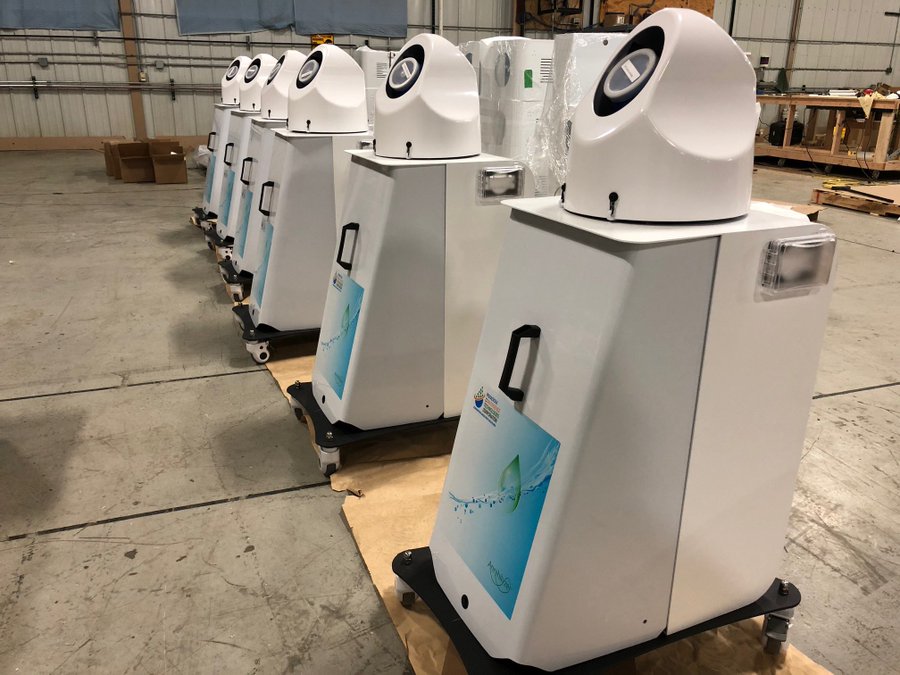
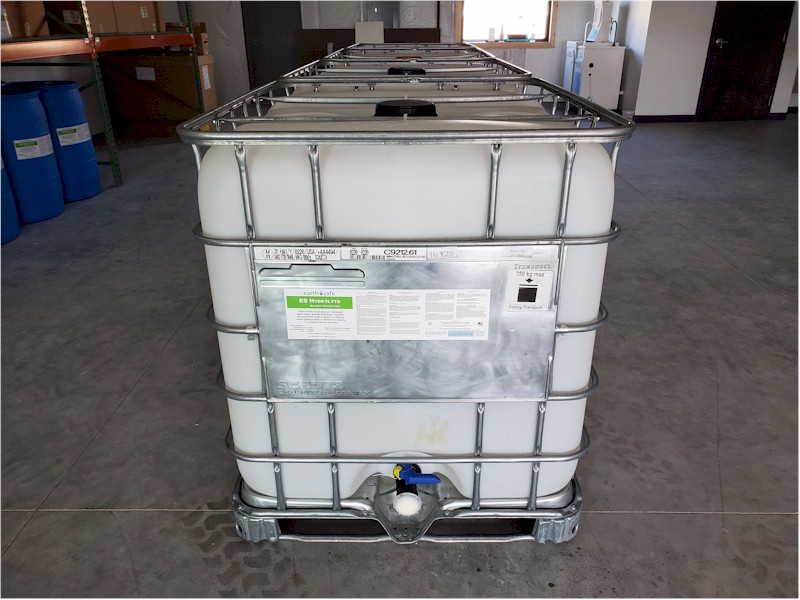
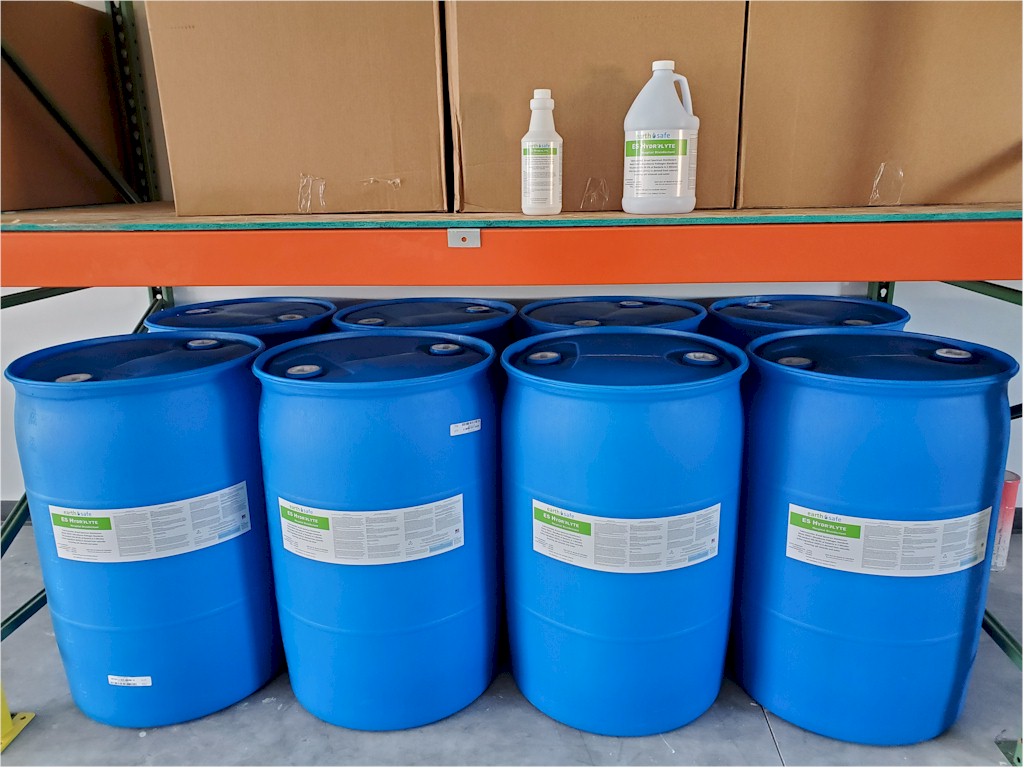
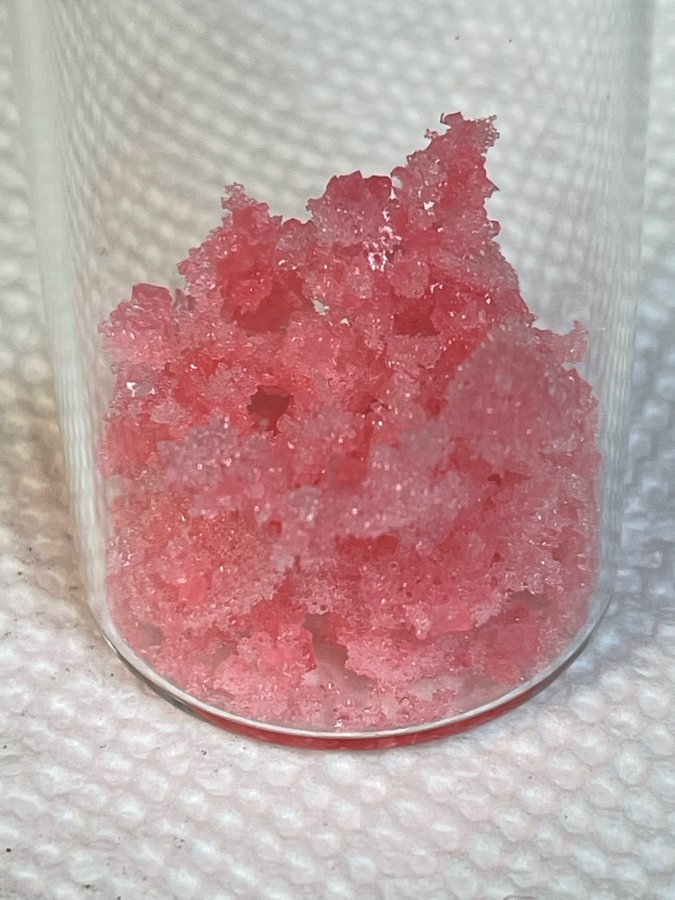
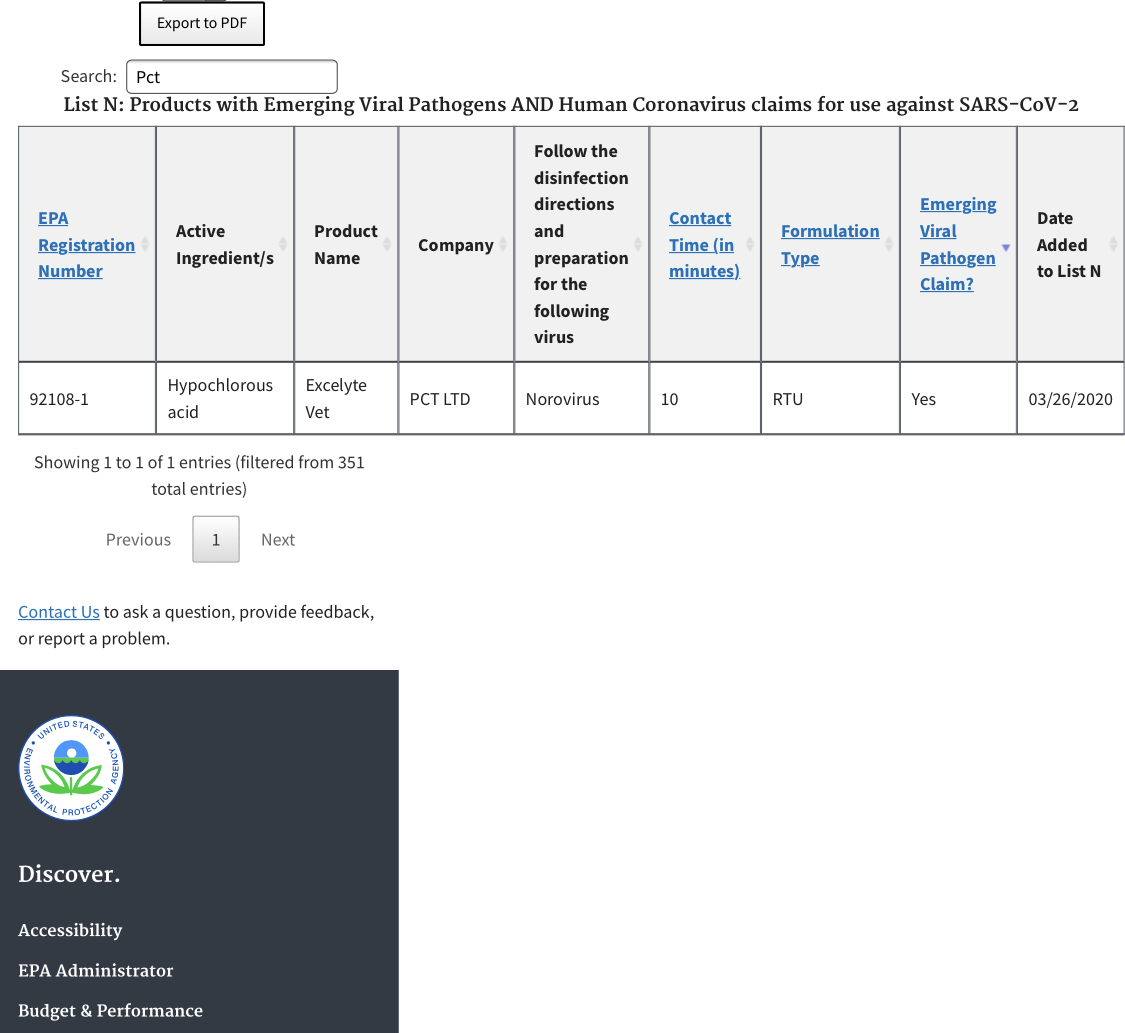

.png)
.png)
Hospital-acquired infections (HAI) — also known as a nosocomial infection — is an infection that is contracted from the environment or staff of a healthcare facility. It can be spread in the hospital environment, nursing home environment, rehabilitation facility, clinic, or other clinical settings. In the United States, the Centers for Disease Control and Prevention estimated roughly 1.7 million hospital-associated infections, from all types of microorganisms, including bacteria and fungi combined, cause or contribute to 99,000 deaths each year.
Our goal is to provide solutions to this issue, by outfitting a healthcare setting with the technology and guidance needed to effectively get the job done - all through a dedicated partnership to prevent and eradicate the spread of infectious disease.
Oil and Gas:
.png)
Waste Water Treatment
Our system helps to decontaminate “frac” water for reuse in the fracking process, saving the industry millions of dollars and preserving the world’s water supply. Some of the many benefits of our system/process include: Elimination of highly toxic chemicals currently used for decontamination, reduced negative environmental impact, reduced recovery costs and potentially opening new areas for oil and gas retrieval.
Turning “Sour” Crude Oil to “Sweet”
In other areas in the gas and oil industry that presents a challenge is in treating existing wells for the presence of H2S of hydrogen sulfide. H2S is a large and growing problem in the industry, due to its continued introduction of bacteria in the fracking process. H2S causes increased production costs. Our solutions reduce those costs and reduce the environmental impact.
Agriculture:
.png)
In the agriculture world, through USDA grants and multiple studies by universities around the world, Hypochlorous acid solutions have been tested and proven effective against yield-reducing crop pathogens in post-harvest applications to include sanitizing at point of harvest, point of packing and points of sale.
We are hoping to help stop these crop-devastating pathogens with our hypochlorous solutions that are known to be environmentally responsible and designed to improve and maintain crop yields, to produce a healthier overall harvest.
School Systems:
.png)
Dedicated to the success of students, schools are faced with a multitude of challenges to reach their goal of providing a solid education and an environment for healthy growth. To add to the list of responsibilities of school administrators, the battle of keeping absenteeism down, preventing the spread of infectious disease and keeping a clean environment bears a heavy load. Not only are the traditional cleaning products losing their effectiveness - thus allowing drug/antimicrobial resistant pathogens to wreak havoc - they are also polluting the indoor air with volatile organic compounds (VOCs) that are known to cause respiratory-related issues, headaches and other ailments.
By providing daycare facilities, school systems and universities with a better alternative to poisonous, caustic chemical cleaning/antimicrobial agents, we’re providing a more productive environment. Not only are you killing germs with a product that eradicates them completely - keeping them from becoming resistant - you’re doing so with a product that doesn’t cause harm to the user, students or faculty.
Hotel and Tourism:
.png)
Similar to the healthcare environment, the hotel and tourism industry (i.e resorts, airports, cruise ships, etc.) are subject to communicable diseases. In the healthcare market, they are referred to as Hospital-Acquired Infections/Healthcare-Associated Infections (HAIs) and in the hotel and tourism industry, they are known as Community-Acquired Infections. With as many different people traveling through these areas, from all sorts of countries and carrying various types of ailments or pathogens with them, consider the potential for an uncontrollable spread of these germs.
Outbreaks are typically caused by lack of proper processes and/or a failing product. Our ECA technology is designed to help anyone in the industry to get a grip on the issue and succeed at their main goal: providing an awesome experience for their guests.
Food Service/Production:
.png)
Our sanitizer strength solution meets the requirement of the FDA and USDA, to be a non-rinse sanitizing agent. In the world of dealing with food, why not use a product that actually kills food-borne pathogens - without containing any toxic chemicals that would harm the quality of the product?
Whether you’re dealing with meat, poultry or just need to maintain a facility’s defense against Salmonella/E. coli, contact us about using our solutions
Forget harsh, toxic chemicals. Our process only requires salt, water and electricity to produce two products –a chlorine-based antimicrobial agent and an excellent degreasing cleaner.
Our technology produces an effective variable PPM hypochlorous acid solution that is created through an electrolytic process called Electro-Chemical Activation (ECA). It occurs by temporarily modifying the properties of water, by passing weak salt brine through an electrolytic cell and temporarily changing the properties of the salt water into a powerful oxidizing agent exhibiting highly effective antimicrobial properties.
Catholyte or sodium hydroxide, is an aqueous solution that is the natural byproduct of the electrolysis process, and is used to reduce microbe contamination and soil loads that can harbor germs on hard surfaces.
Catholyte is also a very effective degreaser and is a great option to safely clean floors without hazardous fumes, thus improving indoor air quality.



| Volume | |
| Day Range: | |
| Bid Price | |
| Ask Price | |
| Last Trade Time: |